An online project under the direction of the CAPE ANN MUSEUM
inv. 85
The Nahant Quadrilles
1836 Lithograph 10 x 8 in. (25.4 x 20.3 cm)
Collections:
|
Additional material
Explore catalog entries by keywords view all keywords »
Historical Materials
Below is historical information related to the Lane work above. To see complete information on a subject on the Historical Materials page, click on the subject name (in bold and underlined).
Filed under: Nahant, Mass. »
Filed under: Nahant, Mass. »
Located seven miles northeast of Boston, Nahant is essentially two rocky islands, connected to each other and to the city of Lynn by a sandy causeway. By the 1830s, it was a well-known resort for summer visitors (mainly from Boston) and as a sea mark for yachtsmen cruising the coast. As conspicuous as its rock formations were, the hotels which occupied Nahant’s southern end offered spectacular views of sea and shore in almost any direction.
–Erik Ronnberg
Yachts and yachting in ninteenth-century America were the preserve of the wealthy, and in Lane's early career were just beginning to organize as yacht clubs with scheduled regattas. The New York Yacht Club, founded in 1844, was the first such organization and had few rival clubs for racing or cruising until after the Civil War. (1) In Boston, by contrast, yachts of any size were few. Instead of regattas, competition was in the form of match races, between two vessels, with cash prizes as a substitute for trophies. Often, the only serious competition for a Boston-owned yacht was one of the crack pilot schooners, and it was not uncommon for a yacht to be sold for pilot service or vice-versa. (2)
If Lane had opportunity to portray any yachts in Boston, only his depiction of schooner "Northern Light" (see The Yacht "Northern Light" in Boston Harbor, 1845 (inv. 268)) has been found to date, and that was based on a drawing by Robert Salmon. (3) It seems likely that he would have depicted more Boston yachts, some of which images might still exist in private collections not currently accessible. For more depictions of yachts by Lane, we must look to New York.
Lane is known to have made two paintings of the schooner yacht "America." The more familiar one The Yacht "America" Winning the International Race, 1851 (inv. 255) was based on a lithograph derived from a painting by Oswald Brierly who witnessed and sketched "America" as she raced for the trophy that now bears her name. (4)
The other painting Yacht "America" from Three Views, c.1851 (inv. 395) was very possibly based on sketches of the designer's half-model, or even the actual vessel under construction. In either case, Lane's drawings and any notes would have been made before the hull and deck details were finalized. (5)
It would not be until August 8, 1856 that Lane would see and sketch a major yacht regatta—held by the New York Yacht Club at New Bedford, Massachusetts. From this event, he painted four known views, each depicting a different moment in the race. The earliest New York Yacht Club Regatta (3), After 1856 (inv. 396) shows the yachts under way to the starting line, with the smallest yachts (third class) starting at 10:50 a.m. The second class would start at 10:55 a.m. and the first (largest yachts) at 11:00 a.m. The second view New York Yacht Club Regatta (2), 1856 (inv. 270) shows the start of the first class; the third New York Yacht Club Regatta (4), 1857 (inv. 397), the race after the start with the large sloops and schooners taking the lead. The fourth New York Yacht Club Regatta (1), 1856 (inv. 66), depicting the finish, shows the winning sloop "Julia" over the line, lowering her racing sails, while the rest of the fleet follows her to the finish line. (6 and 7)
As interest in yachting increased, so did leisure pursuits in smaller craft, using rowing and sailing boats for rowing, fishing, and day-sailing. These activities had a commercial side which is covered in the Party Boats descriptive essay, but this essay will deal with boats used for non-commercial recreation.
Hull types and rigs for small pleasure craft were varied, some being traditional work boat designs with a few added amenities for comfort. Others were designed and built for leisure boating, often in the styles of yachts, but smaller and simpler. Among rowing boats, the dory was a logical choice, the version in View of Gloucester, (From Rocky Neck), 1846 (inv. 57) (right foreground) being smaller, with a wider bottom for greater stability. New England boats (see Norman's Woe, Gloucester Harbor, 1862 (inv. 1), View of Gloucester, 1859 (inv. 91), and Castine Harbor and Town, 1851 (inv. 272)) are also to be found in settings more akin to leisure than to work. (8)
Sailing craft custom-built for pleasure were also depicted by Lane. Examples with sloop rigs are found in The Old Fort and Ten Pound Island, Gloucester, 1850s (inv. 30) (left foreground), Fresh Water Cove from Dolliver's Neck, Gloucester, Early 1850s (inv. 45) (center left), and Coming Ashore near Brace's Rock, Gloucester, Massachusetts, c.1860 (inv. 60) (right foreground). The yawl rig is seen in View of Coffin's Beach, 1862 (inv. 41) (right middle ground), and schooners in Fresh Water Cove from Dolliver's Neck, Gloucester, Early 1850s (inv. 45) (right middle ground) and View of Gloucester, Mass., 1859 (not published) (foreground). These rigs differ only moderately from today's versions; their hull designs remain popular among admirers and owners of "traditional boats."
– Erik Ronnberg
References:
1. William P. Stephens, Traditions and Memories of American Yachting (Camden, ME: International Marine Publishing Co., 1981), 157–59.
2. Ibid., 159–61, 164–66.
3. John Wilmerding, Fitz Hugh Lane, 1804–1865: American Marine Painter (Salem, MA: Essex Institute,1964), 29–30.
4. Erik A.R. Ronnberg, Jr., "Fitz Henry Lane's Yacht America from Three Views: Vessel Portrait or Artist's Concept?," Antiques & Fine Art (Summer/Autumn 2010): 175.
5. Ibid., 174–79.
6. U.S. Nautical Magazine and Naval Journal V (October 1956–March 1857): 16–18.
7. The American Neptune X, no. 3 (July 1950): 231–34. Reprint of an unidentified newspaper account of the 1856 New Bedford Regatta by Robert Bennet Forbes.
8. See the descriptive essay on "New England Boat."
See p. 163.
Also filed under: "Northern Light" (Yacht) »
Parker & Ditson
Courtesy American Antiquarian Society, Worcester, Mass.
Dedicated to the Tiger Boat Club.
Also filed under: Bufford, J. H. Lith. – Boston » // Parker & Ditson, Pub. – Boston » // Sheet Music by other artists » // Thayer's, Lith. – Boston » // Tiger Boat Club »
The Rudder Vol. XV Part 1–3; pp. 387–390, 456–460, 483–486
"Historic American Yachts: Early Boston Vessels, The Northern Light and Coquette."
Also filed under: "Northern Light" (Yacht) »
wood, metal, cordage
Model of schooner yacht "Northern Light" of Boston, 1839
Scale 1:32
Also filed under: "Northern Light" (Yacht) » // Ship Models »
wood, metal, cordage
Model of schooner yacht "Northern Light" of Boston, 1839
Scale 1:32
Also filed under: "Northern Light" (Yacht) »
English-born Thomas Moore was the successor to William S. Pendleton's lithography shop in 1836. Prior to this changing of hands, Moore worked in Pendleton's shop for years as a clerk and bookkeeper. During his four years (1836-40) at Pendleton's 204 Washington Street address, he had under his employ many famous artists, including F.H. Lane, Robert Cooke, and Benjamin Champney. Moore's Lithography printed the usual variety of work, including portraits, town views, public institutions, maps, plans, certificates, cards, etc. In 1840, Moore sold his Boston shop to B. W. Thayer, ending his lithographic career in Boston.
This information has been summarized from Boston Lithography 1825-1880 by Sally Pierce and Catharina Slautterback.
T. Moore's Lithography, Boston
12 1/2 x 9 1/2 in.
20 x 16 3/4 in (Framed)
Cape Ann Museum, Museum Purchase (2014.089.2)
Also filed under: Cod / Cod Fishing » // Johnston, David Claypoole » // Sheet Music by other artists »
One of the first uses of lithography, after its invention in France in the late eighteenth century and its development in America, was for sheet music covers. The music itself was printed from engraved copper plates, which was necessary for the clarity and evenness demanded by the public for the music. However, lithography provided a quick and inexpensive way to provide enticing pictorial title pages, or covers, for sheet music. Pendleton's shop produced the first lithographic sheet music cover printed in the United States in 1826. Much of Lane's work at Pendleton's involved sheet music covers, and examples here by other artists show some of the conventions around the designs.
This information has been summarized from Boston Lithography 1825–1880 by Sally Pierce and Catharina Slautterback.
Parker & Ditson
Courtesy American Antiquarian Society, Worcester, Mass.
Dedicated to the Tiger Boat Club.
Also filed under: Bufford, J. H. Lith. – Boston » // Parker & Ditson, Pub. – Boston » // Thayer's, Lith. – Boston » // Tiger Boat Club » // Yacht & Small Pleasure Craft »
Comp. Marshall S. Pike, Esq.
Also filed under: Bufford, J. H. Lith. – Boston »
Paper, ink
13 x 10 in (33.02 x 25.4 cm)
Peabody Essex Museum (M26784)
"composed and inscribed to Colonel Baquiere, Owner of the "America" Schooner, 1851-1856"
Also filed under: "America" (Schooner Yacht) »
T. Moore's Lithography, Boston
12 1/2 x 9 1/2 in.
20 x 16 3/4 in (Framed)
Cape Ann Museum, Museum Purchase (2014.089.2)
Also filed under: Cod / Cod Fishing » // Johnston, David Claypoole » // Moore's, T. - Lith. - Boston »
Lithographic sheet music
11 x 7 1/4 in.
Boston Athenaeum
Also filed under: Pendleton's, Lith. – Boston » // Salmon, Robert »
Ink, paper
13 x 10 in (33.02 x 25.4 cm)
Peabody Essex Museum
Also filed under: "America" (Schooner Yacht) »
Ink on paper
13 x 10 inches
Peabody Essex Museum, Salem, Mass. (M26750)
Also filed under: "America" (Schooner Yacht) »
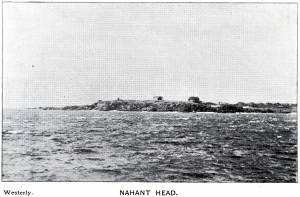
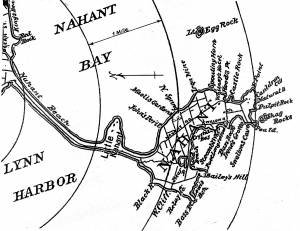


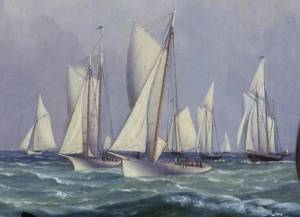
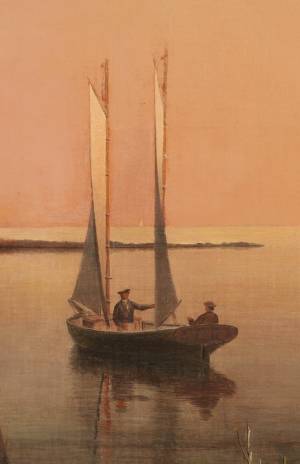



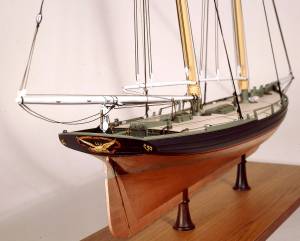

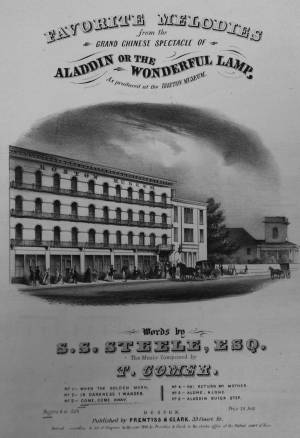

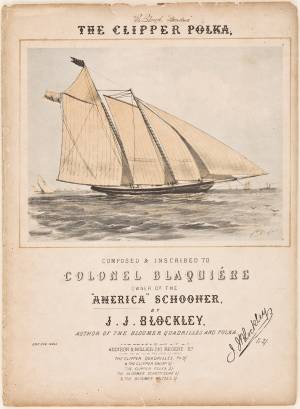
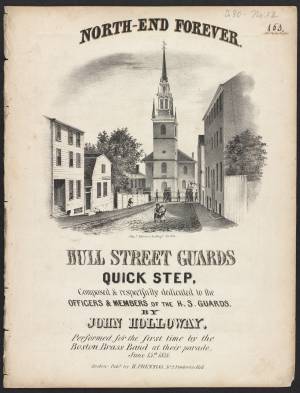
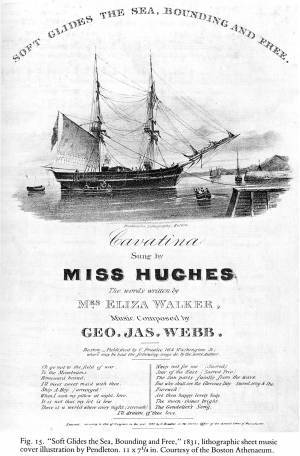

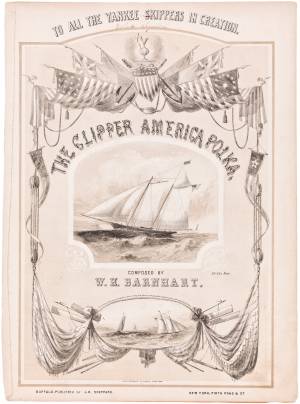
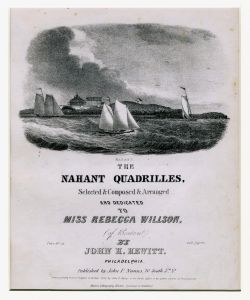
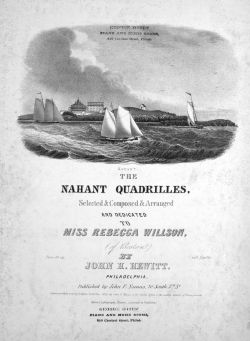

Commentary
This lithograph was drawn on stone by Lane; it is signed in the stone within the design at the lower right, directly under the vessel on the right, at the bottom of the vignette. It was printed at Moore's.
Located seven miles northeast of Boston, Nahant is essentially two rocky islands, connected to each other and to the city of Lynn by a sandy causeway. By the 1830s, it was a well-known resort for summer visitors (mainly from Boston) and as a sea mark for yachtsmen cruising the coast. As conspicuous as its rock formations were, the hotels which occupied Nahant’s southern end offered spectacular views of sea and shore in almost any direction. Two examples figure prominently in this image.
For all its scenic offerings, Nahant did not get the sustained attention of artists until the 1880s. Robert Salmon painted two views of it in 1839; Lane’s painting of Egg Rock (off Nahant’s east shore) was his last exhibition work at the Boston Athenaeum in 1865—and his only known depiction on canvas of this location. William Bradford and Albert Van Beest were active in the Lynn/Nahant area in the 1850s, followed by occasional visiting artists in the post-Civil War decade. The 1870s saw visiting artists regularly, together with recognition of talented local residents whose output was receiving acclaim in Boston galleries. This recognition won for them the group—and style name—“The Lynn Beach Painters.” (1)
All of the works of the aforementioned artists are preceded by Lane’s lithograph, published in 1836. Nothing is known about the preliminary drawing he used – whether it was his or someone else’s—but there is little question that the vessels depicted are either original to Lane or corrected to meet his standards of accuracy. The wave patterns and cloud formations are also in keeping with his style, although there may have been some influence—or tutelage—by Salmon while he had a studio close by Pendleton’s establishment. This view shows three cruising vessels: at left, a schooner (possibly also sailed in yacht races), a small sprit-rigged ketch at center, and a sloop at right.
–Erik Ronnberg
Reference:
1. D. Roger Howlett, “The Lynn Beach Painters: Art Along the North Shore 1880-1920” (Lynn, MA: the Lynn Historical Society, 1998), pp. 12–23.
[+] See More